This series is intended to assist newcomers to the Horus Heresy gaming supplement, talking through the armies, tactics, how to build a force and where to get the miniatures and rules from. Later articles will consider each of the Legions and other factions in this gaming supplement.
So you’re interested in The Horus Heresy? Or maybe you’ve never heard of it, outside of references in the lore of Warhammer 40,000, and want to know more? Perhaps you’ve read a Black Library novel which piqued your interest?
In the article below I outline the narrative setting, the ruleset, the factions involved, and why I think you should play this game – and trust me, if you aren’t playing this, you’re missing out as a hobbyist.
The Setting
It is a time of legend. The galaxy is in flames. The Emperor’s glorious vision for humanity is in ruins… The Age of Darkness has begun.
If you’re reading this website, you will undoubtedly be familiar with Games Workshop’s Warhammer 40,000 universe (otherwise commonly known as “40k”). It’s a game we all know and love, in a familiar and rich setting – albeit one forever changed with the shattering of Cadia, the eruption of the Cicatrix Maledictum, and the advent of the Indomitus Crusade. Mankind is, as ever, beset on all sides by enemies both fair and foul, from Aeldari to Tyranids. War is everywhere, grim and eternal, and the centre cannot hold.
However, this article winds the clock back on all this by 10,000 years and focuses instead on introducing the 31st Millennium – the setting for the popular 40k supplement by Forge World, The Horus Heresy: Age of Darkness (or “The Horus Heresy”/”30k”).
30k tells the tale of the eponymous Horus Heresy, an epic civil war which ripped apart the mighty Imperium of Man at the height of its power and murdered the Emperor’s dream in its crib – His secular Imperial Truth replaced instead by a grim parody in the form of the Imperial Cult and the holy Ecclesiarchy. This war is what led to the current timeline of 40k, and everything can be traced back to it.
By the end of the struggle, trillions were dead. The funeral bell had tolled for the Emperor of Humanity, and all His subjects could do was weep.
It was a time of legends, when the Emperor walked and fought among men, and His gene-sons – the Primarchs – led mighty Crusade fleets to conquer in the name of Mankind. Xenos power was at its nadir, and nothing appeared to stand in the way of the Imperium – except, of course, itself.
The 30k supplement focuses on wargames in this deep and detailed setting, and allows players to field large armies of varying factions, set against each other in exciting tabletop warfare.
So how do you play?
The Rules
The 30k supplement is based on “old” (pre-8th edition) 40k rules, and can be thought of as “7.5” edition in many ways. While there are perennial rumours about it, there are currently no indications of any plans to port 30k into the 8th edition ruleset. Vehicle facings, for example, are here to stay. This means the rules are, in some ways, more “complex” or “crunchy” than 8th edition 40k, but in other ways they are simpler (e.g. there are no individual Movement stats for units).
It follows a similar “I Go Then You Go” turn-based format, with phases people will be familiar with – Movement, Psychic, Shooting and Assault. If you have played 8th edition, picking up these rules will not be particularly hard.
The current rulebook – The Horus Heresy: Age of Darkness Rulebook – took 7th edition 40k and polished it to remove many of the more egregious problems, particularly with balance, that edition suffered from towards the end. Formations giving free upgrades, and powerful “Decurion-style” army structures encouraging only one style of play are a thing of the past.
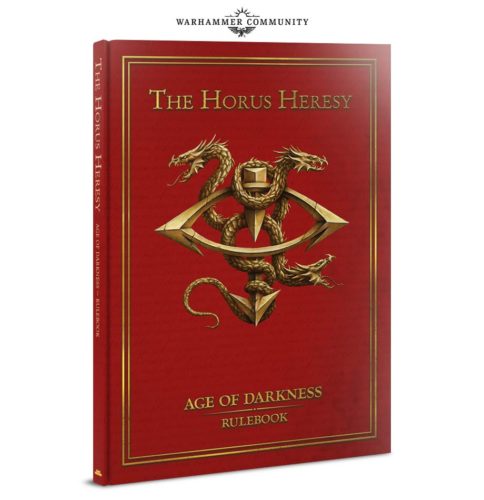
Instead, most of the in-game forces, as detailed further below, are a variety of Space Marine, Mechanicum construct or baseline Human, with the main variety between forces coming within these overarching army structures.
This means the army lists are similar enough to each other to vastly improve the balance of the game from the old 40k 7th edition, while allowing for sufficient options to allow for distinct and varied army builds. It also helps to avoid the “codex creep” of 40k editions, where one army might languish for years without an update, as there are only a few overall forces.
From my personal experience of playing this game for about five years now, I can count on one hand the number of “unbalanced” games I’ve played. That has usually been where, by chance, either myself or my opponent ran a force which was a “hard counter” to the other, or bad luck early in the game caused some key units to go down quicker than they should have done.
The basic books required to get into this game will depend on the force you choose to play, but can be broken down into two or three volumes, with digital copies of each available:
- The Horus Heresy: Age of Darkness Rulebook – The latest version of “the rules”. If you have an old copy of 7th edition 40k lying around, this will generally serve as well to start with as they’re very similar; and
- The Army List for your chosen force.
The army list, depending on the force, will either be contained within what is colloquially known as a “red” book or a “black” book. Later articles in this series looking at forces will set out where to find their (at the time of writing) most up-to-date rules.
The Horus Heresy ruleset is not something which is spread over a lot of small volumes, like modern 8th edition 40k can be (e.g. Codexes, Codex Supplements and Campaign books like Vigilus). At most you’ll be bringing one or two books along to a game.
Black books are officially called Horus Heresy Campaign Books, and are large, coffee-table sized artificer creations of unsurpassed beauty, containing detailed background for the setting, gorgeous colour plates, missions and rules. At the time of writing, there are eight of these, in a mixture of hardback and softback.
Red books are released periodically by Forge World, and condense the content of multiple black books into one volume – they are very similar to 40k codexes, but often contain the rules for several armies at once. At the time of writing, there are five of these, in hardback and digital copy.
By way of example, if I wanted to play the Ultramarines Legion, then I would need, in addition to the Horus Heresy rulebook (or an old copy of 7th edition):
- A copy of the Age of Darkness Legions red book, which contains all the unique units, special rules and Primarch rules for most of the Space Marine Legions (including the Ultramarines); and
- A copy of the Legiones Astartes Age of Darkness Army List red book, which has all the “generic” Space Marine units which are common to every Space Marine army, from Tactical Marines to Typhon Heavy Siege Tanks.
If, instead, I wanted to harness the power of the mighty Solar Auxilia, then I would just need the Horus Heresy rulebook and a single red book, the Crusade Imperialis Army List.
Now that you have an overview of what books you need…
The Factions
The armies in this game can broadly be split between Space Marine and non-Space Marine forces. These are outlined below – keep an eye out for a more detailed examination of each faction in the future.
The Legiones Astartes – Space Marine Legions

It wouldn’t be the Horus Heresy if you didn’t have Space Marines. In the 31st Millennium, the Codex Astartes is only a gleam in Guilliman’s eye, and the Space Marines are instead organised into mighty Legions, numbering in the hundreds of thousands of Space Marines per Legion.
These are terrifying engines of destruction in the hands of their Primarchs, and each Legion can prosecute any type of warfare, from zero-G void assaults to stealth infiltration. However, as you would expect, each Legion also had its own specialisms, which are borne out in the rules.
At the time the Heresy breaks out, there are eighteen Legions active in the galaxy. The Horus Heresy game currently has, at the time of writing, full rulesets for 17 out of the 18, with Dark Angels currently benefiting from partial rules pending the upcoming release of Book 9 (Crusade).
The Legions share a common army list, with units like Tactical Marines, Rhinos and Land Speeders having basically the same statlines regardless of Legion. What differs between each Legion are a number of special rules, unique units (including special characters), and what are called Rites of War.
Rites of War will be covered in more depth elsewhere, but you can think of them as ways of structuring your army which provides army-wide bonuses, while restricting what you can take – an example is Pride of the Legion, which allows Terminators and Veterans to be taken as Troops choices but, among other things, gives up additional Victory Points if these fabled warriors are all killed during the course of the game.
What this means is that, while they are all Space Marines – decent, all round fighters, BS/WS/T/S 4 – each Legion has a very different playstyle.
For example, the Salamanders excel at close-range firefights, with peerless defensive capabilities that can endure a lot of punishment. This sharply contrasts with the traitorous Night Lords, who favour hit-and-run close combats and outnumbering their opponents for bonuses to their dice rolls. There is a Legion to suit everyone, and none are necessarily better or worse than each other – they all play differently.
In addition, outside of the organised Legions are the Blackshields – Astartes who, in the chaos of the Heresy, have struck their heraldry and answer to no master.
The model range for Space Marines is vast – they are the most popular army produced for 30k and 40k by Games Workshop and Forge World. The Heresy model range can be found on Forge World, and is mostly in resin – many of the key units are, however, now done in excellent plastic kits by Games Workshop.
The Mechanicum Taghmata
The Mechanicum are not to be confused with the more “modern” Mechanicus – these are the old-school followers of the Omnissiah, and are not to be trifled with.
The force is based around the Taghmata – the military arm of the Mechanicum – with subsections such as the Legio Cybernetica (who specialise in Battle-automata of varying degrees of lethality) and Ordo Reductor (the Tech-Priests you call if you need to level a city in an afternoon). These subsections work in a similar way to Legion Rites of War, and you can further flavour the army depending on the chosen specialism of the Archmagos who leads it.
The Mechanicum field extremely tough units – the majority of the army list has multiple wounds, a high toughness, and access to special rules such as Feel No Pain. They also can deploy unique and powerful weaponry, such as Lightning Guns and Rad Cleansers, alongside esoteric vehicles like the Krios and even the mighty Ordinatus.
Their armies – unless you are fielding scores of mindless Tech-Thralls – tend to be small and specialist, and they are a converters dream, with infinite grimdustrial modelling opportunities for each unit.
They, like the Space Marine Legions, benefit from excellent plastic and resin model support from Games Workshop and Forge World – a bit of converting can see more “modern” Mechanicus kits be pushed into service for the Mechanicum – for example, the Kataphron Battle Servitors or Sicarian Infiltrators are kits I have seen time and again used to great effect.
Imperialis Militia & Cults
Imperialis Militia & Cults are a broad church – less of an army list, more of a sandbox for customising a 31st Millennium ‘Astra Militarum’ force.
The entire force revolves around Provenances of War, which can be purchased by a Force Commander HQ. These massively impact the type of army you end up with, and some are mutually exclusive. Different units either get bonuses or drawbacks, and some unit options can be made mandatory or completely excluded depending on the combination used.
For example, Gene Crafted gives additional strength and initiative to your soldiers – putting them on par with Astartes in those stats, and emphasising an army of close-combat brutes. Alternatively, Abhuman Helots boosts your toughness, but at the cost of a point of initiative – a benefit for large squads of ranged fighters. If you want to drown your opponent in noisesome flesh, then the Cult Horde provenance means you can only ever snap shoot – so leave the tanks at home – but your cultists’ combat ability and morale is boosted significantly.
The army list contains what you would expect for an ‘Imperial Guard’ style army – Leman Russes, Sentinels, heavily customisable Ogryns and a number of flavours of Super-Heavy Tank all make an appearance, alongside a range of infantry types.
Again, these are a converters dream, and it is very easy to simply use the existing plastic Games Workshop ranges to represent this force, with any Forge World upgrades you wished to add. Cadians or Vostroyans would be great with the Warrior Elite leadership-boosting Provenance, whereas a Beastman plastic kit (and a bit of kit-bashing) would be an archetypal Abhuman Helot slave-mob. Alternatively, a third-party manufacturer, Anvil Industries, does a simply staggering “Regiments” range which needs to be seen to be believed. The sky is the limit!

The Solar Auxilia
These are the great-great-great grandfathers of the 40k stormtroopers – basic human warriors armoured in advanced environmental suits, escorted by souped-up Leman Russes and light tanks.
The Solar Auxilia range is unique to the Horus Heresy, and are, in my opinion, some of the best looking models produced by Forge World. The army on the tabletop has a very different playstyle to the Imperialis Militia & Cults, focusing around Tercios of infantry supported by mechanised elements or specialists like Medicae, Charonite Ogryns (Ogryns in power armour!) or Engineseers.
The army has a large number of tricks up its sleeve, such as items which limit the charge range of an opponent, or boost the strength of lasguns temporarily so they can take out even tanks.
There is a downside to this force which is unavoidable – the real-world cost. I will let you go to the Forge World website and look up the price of an 100-point Lasrifle Section, and leave it to you to decide if it’s worth it.
(As someone with 3,000 points of Solar Auxilia – it is).
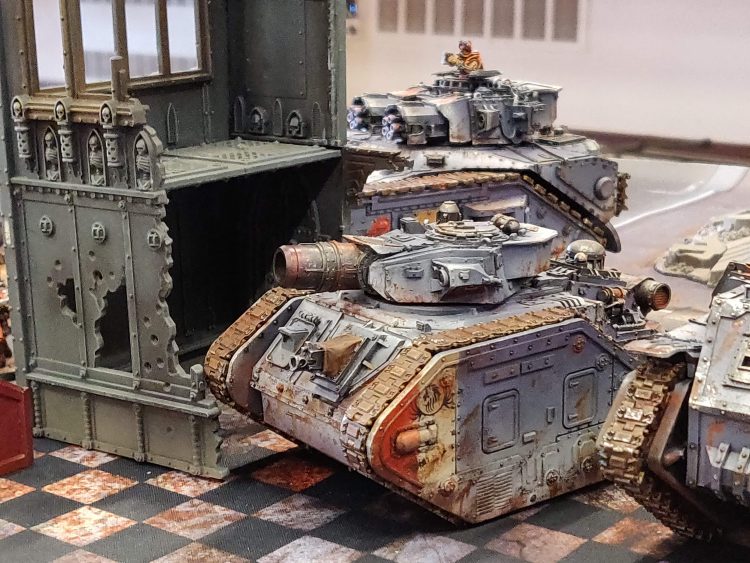
Questoris Knights
This list will be familiar to anyone who plays 40k – an army based around humans piloting massive bipedal armoured warsuits called Knights, supported by nimble Armigers.
There is now a large range of plastic and resin Knights and Armigers available (including in the form of upgrade sets), and they are some of the best kits produced by Games Workshop and Forge World. These models are also well supported by third party manufacturers who make excellent customisation options.
The army is extremely hard hitting on the tabletop, but is vulnerable with its low model count – Knights are not particularly sturdy, and dedicated anti-tank weaponry can often wipe them out in a turn. Care needs to be taken when building a list to make sure it can handle all types of opponent, and not to overly rely too much on one Knight which might be taken out early in the game as it is such a threat.
From a painting and modelling perspective, Knights are a perfect canvas – there is a wealth of information published by both Games Workshop and Forge World on different Houses, heraldry and history, with a range of excellent transfer sheets for the most popular “official” Houses. With the release of Adeptus Titanicus, Knights are getting even more attention, and so are a great force to look into – particularly as they can also be used in other game systems.
Talons of the Emperor
The elite of the elite, the best of the best, armed with arcane techno-artificer weaponry and clad in gleaming Auramite or coal-black Selenite void-mail. The Talons list is made of two sub-factions: The Adeptus Custodes and the Sisters of Silence.
They are His chosen Protectors and Daughters, and represent specialist, unbelievably powerful strike forces launching counter-attacks against the Traitor forces as they close on Terra.
The Custodes are a very low model count force made up of peerless warriors with high statlines and strong weaponry, much of it causing Instant Death or cleaving through even the strongest Terminator armour. They are supported by a fleet of grav-vehicles and ancient Dreadnoughts following their own specific patterns, and, if the need is dire, they can requisition Orion and Ares pattern Super Heavy Flyers to scour the field clean.
The Sisters are a very different style of army, consisting of low-toughness Sisters who exude an anti-psyker Null Field. They can requisition a bevy of anti-psyker and anti-daemon equipment and weaponry, and are often seen supporting other loyalist forces on the tabletop rather than fielded as an army in their own right.
These ranges are available mostly in plastic, and have rules in 40k – so, like the Questoris Knights or Imperialis Militia & Cults, can be quite a good force to start with. You don’t have to stick to the standard gold or black either – the Custodes have been known to come in silver, or purple for example.
Daemons of the Ruinstorm
The newest force on the tabletop, and still being “digested” by the community. It’s another sand-box style list, intended to encapsulate all the various denizens of the Empyrean forcing their way into realspace during the course of the Heresy.
One important thing to note is, while Ruinstorm armies can be flavoured using Aetheric Dominions (like Rites of War), there are explicitly no “Khorne” or “Nurgle” daemons during this time period. The malign intelligences of the Warp were still largely unknown during the Heresy, and their servants reflect this.
The army is reasonably complex, but, in summary, you select various basic Ruinstorm units, and then apply upgrades across whole squads or to individual models from a list of Emanations of Horror – for example giving them a shooting attack, or a better armour save. The cost of this will depend on the Emanation/unit combo in question.
Daemons also have their own unique objectives in tabletop missions – they aren’t interested in capturing laptops or objectives – and deploy from Warp Rifts placed on the table during the deployment phase. At the start of the game, all Daemon models are naturally stronger and tougher, but as the game goes on and the Warp begins to fade, they get weaker. This makes them very different to both play with and against compared to other Heresy armies.
The general consensus at present, unfortunately, is that the Ruinstorm list is quite easy to “break” due to its sandbox nature – but the latest Campaign Black Book (Book 8: Malevolence) introduced a range of anti-Daemon (and anti-Psyker) wargear and units which may come into their own as Daemons see more play.
In terms of the models, there are almost too many to list, from Games Workshop, Forge World and third party retailers. The army list explicitly encourages gamers to go wild with conversions, provided a range of base sizes for each unit type are broadly adhered to. It is, as a result, probably the easiest army to currently get into – provided that you exercise a bit of sensible restraint in building your list.
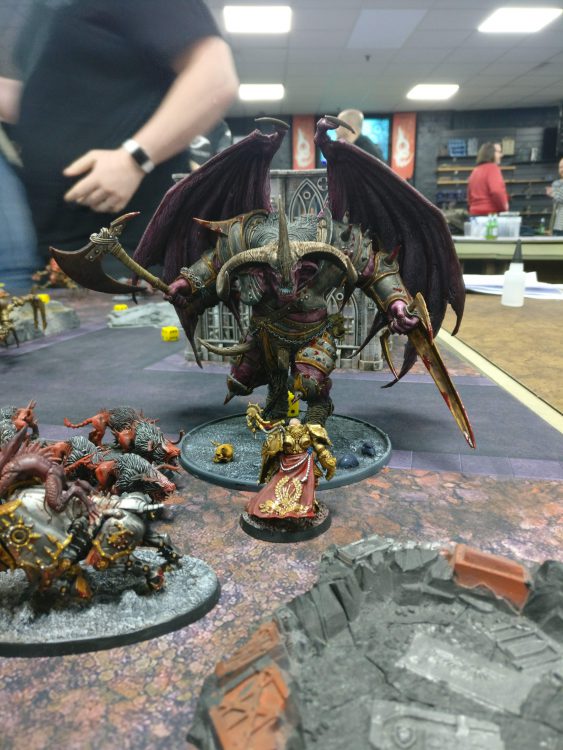
Why play Horus Heresy?
Full disclosure – I live and breathe this game and the setting. I have most of the campaign books, and at the time of writing have fully painted armies for Imperial Fists, Daemons of the Ruinstorm and Solar Auxilia, with a smaller Raven Guard contingent and some growing Salamanders.
I have played 40k and other Games Workshop games since the 1990s, and have a passion for this hobby – but it is the Heresy setting which has grabbed and kept my attention, no matter what. So why is this?
I think it can be broken down into three primary reasons – the setting, the community and the models.
The Setting
The Horus Heresy is probably the most explored and written about time period in the Warhammer 40,000 overall narrative. It spans a roughly seven year period, yet there are over fifty Black Library novels, countless audio-dramas, short stories and eight large Campaign Books written about it- and that is just the “core” fluff.
The story draws on epic, quasi-Biblical themes of hubris, loss, betrayal and, ultimately, what it actually means to be human. That might sound a bit “grand” for what is just a glorified game of space-barbies, but if you read and get into the background for this setting, you will see what I mean.
One of the most interesting things about the Heresy setting is how it is treated as a “future historical” setting. We know what happened in the Heresy – Horus rebelled, and it culminated in the Siege of Terra, with the Emperor fighting the Warmaster aboard the Vengeful Spirit at the climax. Horus was killed, and the Emperor was mortally wounded. Surely that is all there is to know?
Well yes, and no. That might be the overall story, but that is like describing the First World War as “Germany invaded Belgium, and it culminated in Allied victory and the Treaty of Versailles”. If that was how it was described, wouldn’t you be asking “What about the Somme? What about the Battle of Jutland? Gallipoli? The 12 battles of Isonzo? That isn’t the whole story!”
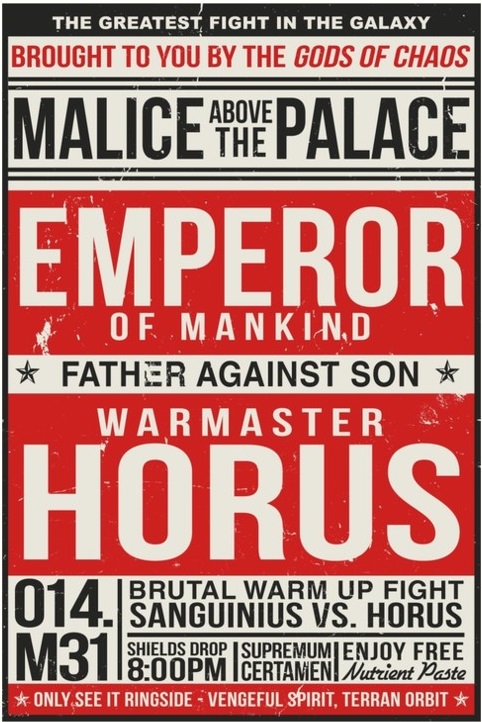
And you would be right! What the Horus Heresy setting explores is how that ultimate climax – which everyone knows – was reached, and the grim and bloody struggle along the way. It highlights the atrocities committed by the Traitor forces in their march on Terra – from the murder of the Veridian Star over Calth, to the tragic slaughter of the Loyalists in the Drop Site Massacre.
This is juxtaposed with tales of glorious heroism by the Loyalists, from the ultimately-doomed delaying tactics of Shadrak Meduson and his Shattered Legions to the epic boarding of the Contrador at the height of the Battle of Phall.
Every battle you play on the tabletop can be framed in this overall “future-historical” structure, and it allows you to really breathe life into your armies.
Your forces aren’t just “Salamanders Company 5” – they’re the Geryon Deep Retribution Fleet, sent forth from the Geryon Deep permanent garrison after the Drop Site Massacre to wreak bloody vengeance for the destruction of the Salamanders Legion. Or your Sons of Horus are a faithful recreation of Falkus Kibre’s 1st Company Widowmakers, first in and last out.
In summary, the setting, and the books in which it is presented, are a huge draw. If you want hobby inspiration, look no further than a black book.
The Community
Some people might raise their eyebrows when I extol the virtues of the Horus Heresy Community as a selling point for the game. There is, sadly, something of a reputation for “gatekeeping” in a very small (but unfortunately vocal) section of Heresy players.
Personally, that is not something I have really experienced. In fact, I am willing to boldly make the claim that the Heresy community is the best Games Workshop hobby community.
Heresy players, in my experience, trend towards those who have a real burning passion for their hobby, and spend a lot of time building, converting and painting their miniatures to create the best possible collection they can. This is reflected in the quality of armies you can see for this setting online and in person – below I set out some photographs from events I have been to, which gives a flavour of what I mean.
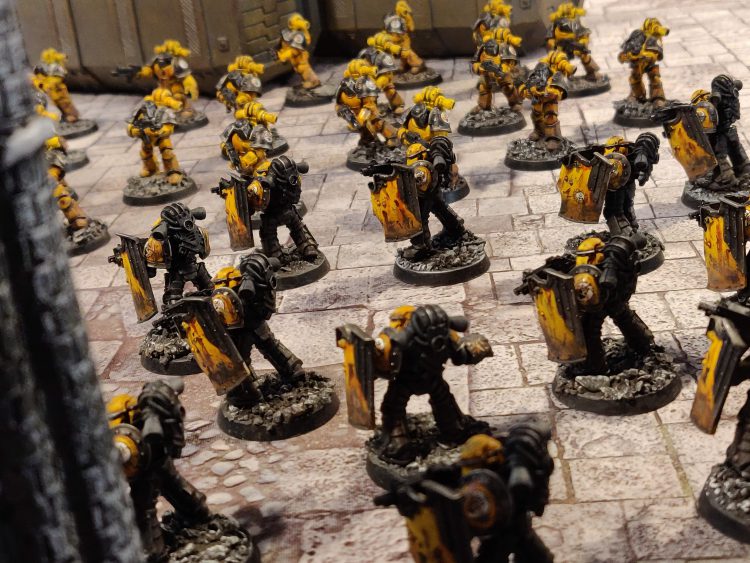
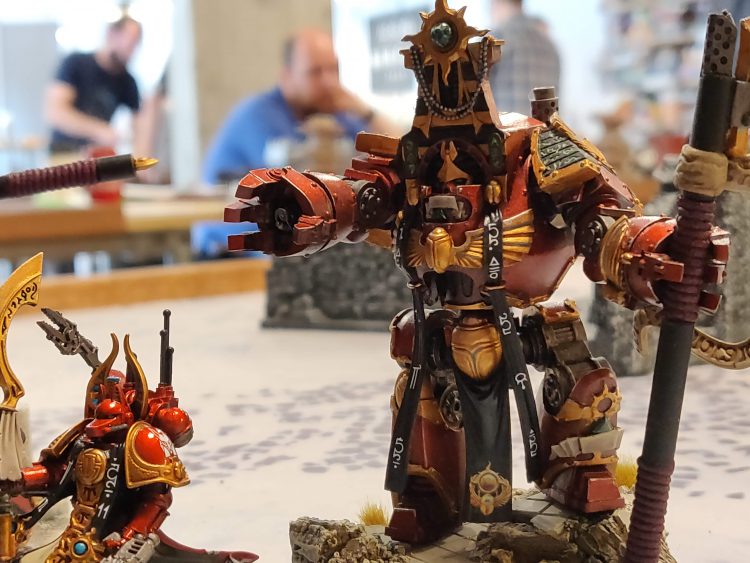

The community is also highly invested in the concept of “Heresy Events”, which are usually narrative-focused (Traitor v Loyalist) 1-2 day gaming sessions. At these, you have a showcase of A+ grade fully-painted armies duking it out on complete tables of painted terrain – the pinnacle of our wargaming hobby.
The stories from these events often carry over into an overarching narrative, often with the same characters in people’s armies who develop over time. An example is the “Deserts of Helio Centius” series run by The Flaymaster – now on its third event at the start of next year, it pits the participants against one another in the ongoing battle for the planet Helio and its moon. The real enemy, however, is the local wildlife, which is hyped up on local exotic Spyce, and hungry for blood…
These are great ways the Heresy community has really built their own ecosystem of gaming, and stretches as far as entire Hobby Camps, where people go and stay in campsites and play Heresy outdoors (I know – they go outside! Into natural sunlight!) It’s amazing, and I count amongst my very good friends people who I have met at these events.
The Models
Finally, the models – where would we be without them? This entire hobby revolves around these, and the Heresy range are some of the finest miniatures produced by Forge World.
I don’t think I really need to say too much about these other than encouraging people to go and look at them on the Forge World website. The models ooze character and grit, and are often multi-pose and easily converted, being made primarily of resin.
I set out a selection of my favourites below – the Gal Vorbak for the Word Bearers, Phoenix Terminators for the Emperor’s Children, and the Primarch Vulkan of the Salamanders. Each one, I feel, is a good “flagship” miniature for its individual Legion.
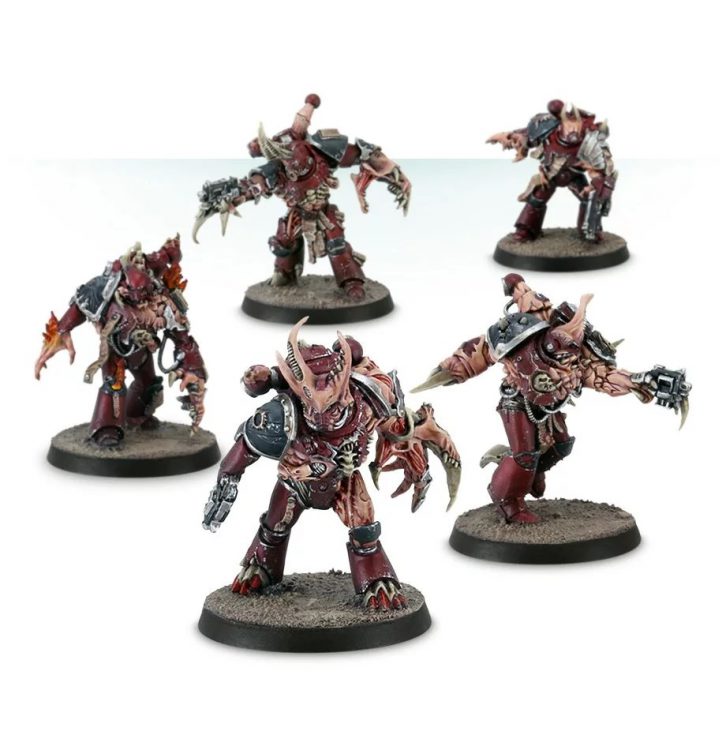


Conclusion
This article has gone on far longer than I thought it would – but perhaps you can take that as a good indicator of how much I love the Horus Heresy. If I can convince even one person to try this game out, then it will be worth it – we are always trying to grow the community, and new players are always welcome.
Keep an eye out for an upcoming article in which we’ll consider the most perfect of Legions – the Emperor’s Children.


